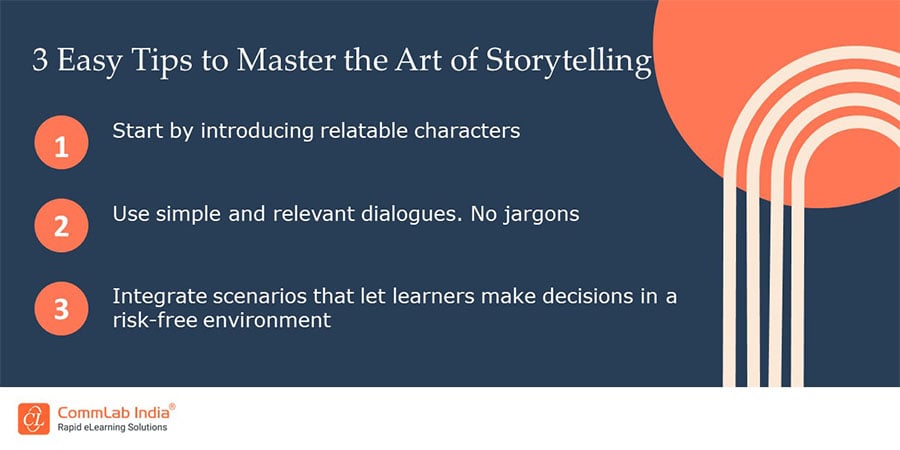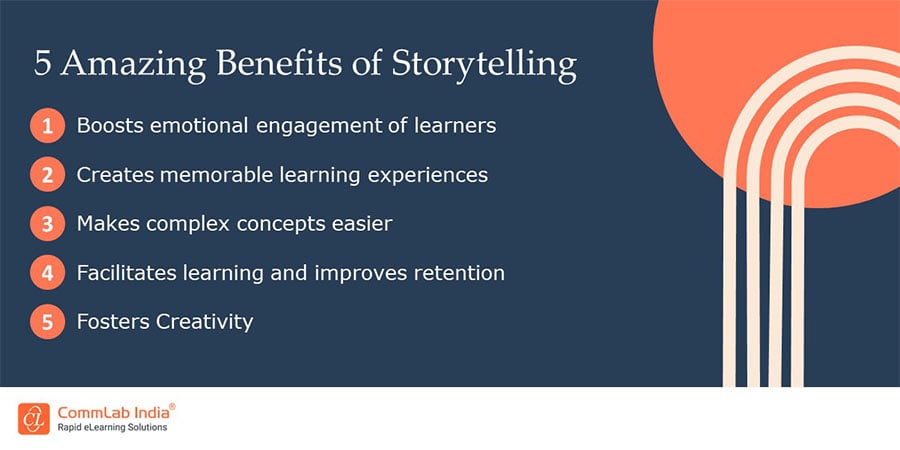7 Amazing Tips to Include Storytelling in eLearning to Scale Your Training Initiatives

Stories have fascinated us for centuries. They became a means to pass on information, teachings, and traditions across generations. Storytelling is still a great way to engage and reach your audience. With the advancement of technology, we can find multiple ways to include narrative by harnessing the power of storytelling. This instructional design (ID) strategy has proven to be an effective way to enhance learning, which is why many organizations have started incorporating storytelling techniques in their eLearning initiatives. If you too are ready to reap the benefits of this powerful strategy, this blog is for you. Read on to get quick tips on how to incorporate storytelling in eLearning.
Storytelling Can Work Wonders for Your Learners
Here are a few quick tips to include storytelling in eLearning:
- Understand your learners
- Plan the setting
- Create relevant and relatable characters and storyline
- Apply the narrative to the content effectively
Read on to get more tips
Amazing Tips to Include Storytelling in eLearning
Storytelling can be utilized as a primary factor or an added element to deliver content and improve the learning experience. You can use multimedia elements to come up with an interactive learning experience for your employees. Here are some useful tips to include storytelling in eLearning initiatives:
Understand Your Learners
Any story loses its charm if there is no listener. It is important to know that identifying your learners’ interests is the first step to creating an ideal story to incorporate into the eLearning process.
You need to understand what would appeal to your employees. Determine their desires, wants, and interests to create a compelling story. Moreover, be clear on the purpose of the digital storytelling narrative by:
- Highlighting your goal
- Determining the expected outcomes
- Realizing the purpose of creating the story
Once you are well aware of these factors, you will be able to shape the perfect narrative for your employees.

Plan the Setting
Your storytelling will be less interesting if it isn’t planned. You will end up confusing the learners instead of helping them learn without planning the narrative. Instead of rushing into the story, you need to create a plan.
Start by identifying the learning objectives and the role of your learners. Determine if it would be possible to stretch the story throughout the eLearning program. Plan the start, middle, and conclusion of the story to effectively use it throughout online learning.
Avoid making the story complex. Keep it simple by determining the central conflict and ways the content of the training drive the different stages of the story. For instance, if the narrative is superheroes saving the world, incorporate your employees as superheroes who are rising through the ranks to reach higher professional levels. Make sure the story aligns with the culture and mission of your company.
Create Relevant and Relatable Characters and Storyline
One of the best ways of using storytelling in eLearning is to establish relatable characters and storylines relevant to the content. Every character you use in the story must be relatable to the learners, the dialogues must be realistic, and the personalities of the characters must be relatable to the learners.
You can even base the character on an individual or incorporate a few characteristics of multiple employees in a character. However, highlight the skills missing in the character you are trying to teach with the eLearning initiative.
The story and the characters are the vehicles you use to achieve the learning outcomes of the online training course. You can also incorporate lighthearted conversation or humor within the story but ensure the narrative doesn’t go off-topic. Avoid overwhelming the employees with irrelevant information.
→ Download eBook: Instructional Design Strategies to Design Engaging eLearning Courses
Establish a Level Structure
Nothing can make the online learning course more useless than disorganized or unclear. Adding a story to the eLearning course that makes no sense will only confuse the learners and end up wasting valuable time and resources.
The story must have a proper structure. For instance, include multiple levels in the course, particularly if you use a gamified learning method. When the employee goes through one level, they level up and can access the content for the next level.
Adding levels in the structure will provide a series of clear progression, keeping the learners engaged and motivated to continue. Both the story and the course can be structured this way. Divide the storyline among the levels so the narrative continues as the learner progresses.

Use Quality Images to Highlight the Story
Add quality images and videos to represent the main elements of storytelling visually. This will help in drawing the attention of your learners to the main points you want them to absorb. You can either use your own images or benefit from the royalty-free images.
Be sure to keep the emotions of your learners in mind when selecting the visuals. Use inspirational or symbolic images or videos to represent the story and keep the interest of the learners. Avoid using irrelevant visuals, as this will only distract and confuse them, resulting in them losing interest in the content.
Apply the Narrative to the Content Effectively
Once you have the storyline established and selected the visuals, it is time to implement it in the content. This is an important step as you need to ensure you do it right, or the storytelling will end up distracting the learners.
All your resources and time could be lost if you aren’t implementing the narrative properly within the eLearning initiative. Bland and irrelevant training courses could create a disconnect between your initiative and the content you created.
Weave the storyline into the content rather than the other way around. You can modify or keep some parts out if they seem irrelevant. Moreover, you don’t have to incorporate storytelling in each and every aspect of the training.
In the simplest form, you can establish relatable characters with a minimal storyline if you are unsure about your story. It doesn’t have to be implemented in all parts of the program. The key is to tie the content together with the story throughout the program, even if the narrative appears after a few gaps.
Want more tips on effective eLearning strategies to enhance learner engagement? Watch this video now!
Make it Interactive
Lastly, the most important thing to factor in when using storytelling in your eLearning programs is to keep it interactive. Avoid using lengthy paragraphs in the course and, instead, make a presentation or slide show to share the content and story. There are many easy-to-use eLearning authoring tools with a short learning curve that can help you design interactive courses. These authoring tools offer a rich multimedia library and customized templates which can be leveraged to design engaging eLearning courses.
Give your learners a chance to make their own progress by clicking through and making decisions as they progress through the content. This will enhance their critical thinking and decision-making ability while also learning the content you want to teach.
It might take more effort and time to make the eLearning initiative more interactive, but it will drastically enhance the learning experience of the learners. Moreover, after the first eLearning program with storytelling techniques, it will get easier for you to either expand the story for different modules or create a new one for a different online training session.
Wrapping Up
Training your employees through storytelling is a great way to boost concentration and enhance involvement with the course content. It is one of the most effective ways of engaging learners of any age and profession while making it easy for them to retain the knowledge they learn. It is important to understand that storytelling isn’t just a tool but an instructional design strategy to enhance the quality of the course content and add value to the eLearning initiatives. With just a little bit of experimentation, creativity, and imagination, you can make online training more appealing for your learners and enhance learning outcomes.
This is not all. There are a few more popular instructional design strategies that can make your eLearning courses learner centric. Grab this handy guide to explore popular ID strategies to take your eLearning initiatives to the next level.




![Tell a Story to Make a Champion: Using Storytelling in eLearning [SlideShare]](https://blog.commlabindia.com/hubfs/Imported_Blog_Media/elearning-corporate-training-storytelling-why-how.jpg)
